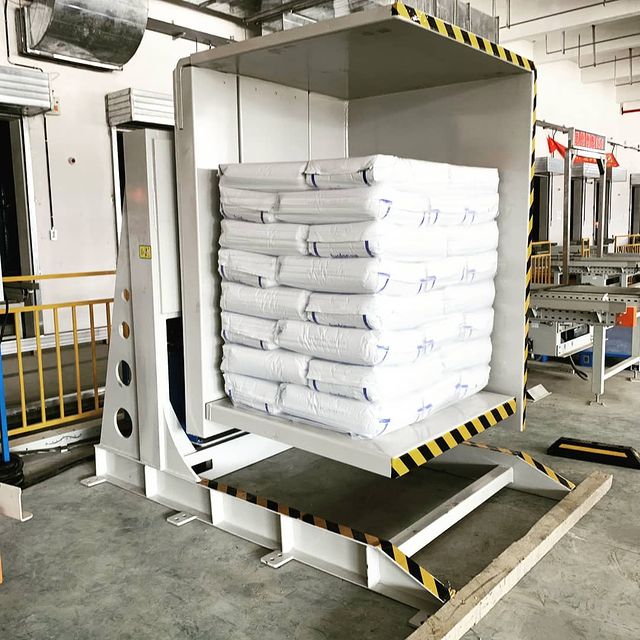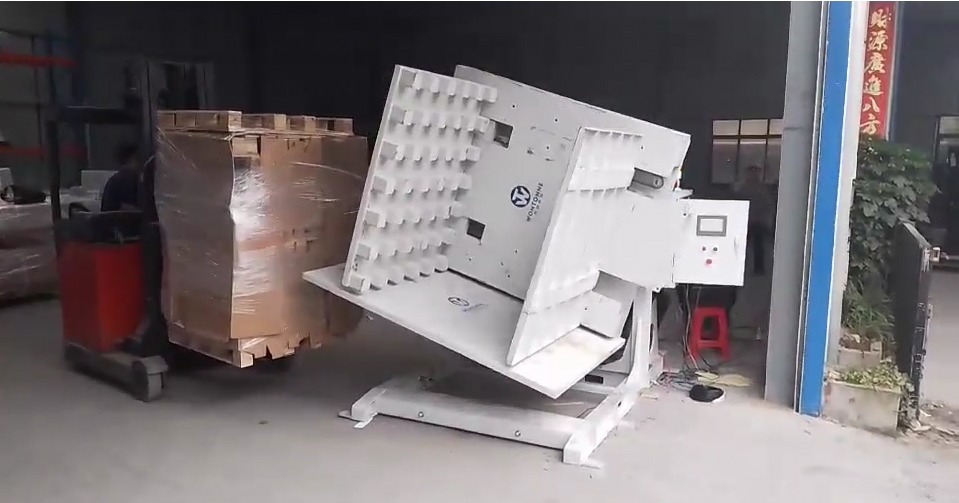# The Silent Revolution: How Pallet Inverters Are Reshaping Modern Warehousing
In an era where supply chain efficiency defines corporate survival, a quiet innovation is transforming warehouse operations. Pallet inverters—unassuming machines that rotate or flip loaded pallets—are rewriting the rules of material handling. These devices, once niche tools, now sit at the heart of logistics strategies for industries ranging from pharmaceuticals to retail.
What Exactly Is a Pallet Inverter?
At its core, a pallet inverter is a mechanical problem-solver. Imagine a machine that can flip a 4,400-pound stack of flour sacks as effortlessly as a chef tossing a pancake. This equipment securely grips palletized loads—whether wooden, plastic, or even slip sheets—and rotates them up to 180 degrees. The magic lies in its hydraulic system and adjustable clamps, which cradle products with precision, preventing spills while enabling tasks like pallet replacement or product rotation.

The implications are profound: Damaged pallets no longer require hours of manual restacking. Contaminated shipping platforms can be swapped for clean ones in seconds. Entire industries reliant on precise product orientation—think steel stamping or pharmaceutical packaging—now operate with surgical efficiency.
The Anatomy of Efficiency: How These Machines Work
Every pallet inverter operates on three pillars:
- The Frame: A steel skeleton built to withstand forces equivalent to an SUV dangling from a crane.
- Clamping Mechanism: Customizable arms that adapt to pallet sizes, applying pressure gentle enough for egg cartons yet firm enough for industrial machinery parts.
- Hydraulic System: The muscle behind the movement, capable of rotating multi-ton loads in under 20 seconds.
The process is deceptively simple: Load the pallet, engage the clamps, execute the rotation, and release. What once took a team of workers 30 minutes now happens in the time it takes to brew coffee.Stationary vs. Portable: Choosing Your Warehouse’s Workhorse

Stationary Pallet Inverters
These fixed installations are the heavy lifters of the family. Designed for operations processing 50+ pallets daily, they offer:
- Colossal Capacity: Models like Cherry’s Industrial dual-clamp units handle up to 8,800 pounds—equivalent to flipping a fully grown African elephant.
- Customization: Adjustable throat openings (up to 66 inches) accommodate everything from euro-pallets to oversized aerospace components.
- Safety Architecture: Laser-guided sensors and emergency stop systems reduce workplace injuries by 72% in FDA-regulated facilities.
Ideal for: Automotive parts suppliers, bulk food distributors, and pharmaceutical giants requiring GMP-compliant handling.Portable Pallet Inverters
The nomads of pallet handling, these wheeled units bring flexibility to constrained spaces. Key advantages include:
- Space Optimization: At 48”x48”, some models fit into corners smaller than a standard office cubicle.
- Cost Efficiency: Rental options from providers like Top Industries Inc. start at $1,200/month—less than the salary of a single material handler.
- Quick Deployment: Integrated conveyor systems allow installation in under 90 minutes.
Ideal for: Pop-up fulfillment centers, seasonal agribusiness operations, and urban micro-warehouses.Industry-Specific Transformations
Food & Beverage
A major bakery chain reduced product loss by 37% using stainless steel inverters to swap wooden delivery pallets for hygienic plastic ones. The machines’ FDA-grade surfaces eliminated microbial contamination risks while handling 120 pallets/hour.

Pharmaceuticals
When a COVID-19 vaccine distributor needed to rotate temperature-sensitive shipments without breaking cold chains, freezer-ready inverters with -20°F capability became their linchpin. The machines’ precise control prevented $2.3 million in potential spoilage monthly.
E-commerce
During peak seasons, a leading retailer uses portable inverters with AI vision systems to automatically reorient mislabeled packages. This slashed sorting errors by 64% while processing 850 pallets daily.
The Buyer’s Dilemma: 10 Critical Selection Factors
- Load Intelligence: Beyond weight capacity, consider center of gravity. A 4,000-lb inverter handling top-heavy loads may need 20% extra margin.
- Cycle Time: High-throughput operations require <25-second rotations. Air Technical’s automated models achieve 17-second cycles through PLC controls.
- Energy Footprint: Look for ISO 50001-certified models. Modern inverters use regenerative hydraulics, cutting power use by 40% versus 2010 models.
- Integration Depth: Can it interface with your WMS? Some units offer API connectivity for real-time inventory tracking during rotations.
- Failure Metrics: Top-tier suppliers guarantee <0.5% downtime. Analyze mean time between failures (MTBF)—aim for >10,000 hours.
- Ergonomic Design: Height-adjustable control panels reduce operator strain. Models with haptic feedback see 22% faster adoption by veteran staff.
- Regulatory Compliance: For chemical handlers, explosion-proof certifications (ATEX, IECEx) are non-negotiable.
- Climate Resilience: Rubberized components prevent hydraulic fluid thickening in freezer applications.
- Upgrade Path: Modular designs allow retrofitting—a $15,000 sensor upgrade might add automated damage detection.
- Total Cost Analysis: Factor in energy, maintenance, and productivity gains. A $85,000 inverter often pays for itself in 14 months through labor savings.
